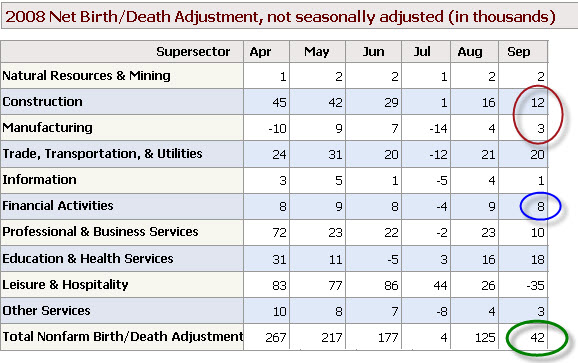While I consider the employment report to be among the Fuzziest of Numbers, I still look at it when it comes out (like it did this morning at 8:30 a.m.) because there is some value in the trend, even if the number itself is not worth much.
Plus, seeing the amount of fudging in the Birth-Death model is one of my favorite activities, because I think it provides insight into just how unreliable government statistical models really are.
[quote]WASHINGTON (MarketWatch) – U.S. employment fell by 159,000 in September, the worst job losses since March 2003, the Labor Department reported Friday.[/quote]
This would have, of course and as always, been even worse had the infamous Birth-Death model not inexplicably added 42,000 jobs to the count.

Note that even construction jobs were added (red circle), even though both
residential and commercial construction spending are in heavy retreat.
Manufacturing (red) recorded a rare gain, even with the collapse of the auto
industry. Note that financial activities (blue) were said to have added jobs,
in the midst of the greatest financial crisis and associated job losses
in recent history. One wonders, what exactly do they use as inputs to
this model?
Without the 42,000 added jobs, job losses would have been reported as being over 200,000.
The unemployment rate was steady at 6.1% as expected, the government said. An alternative measure of unemployment that includes discouraged workers rose from 10.7% to 11%, the highest since April 1994.
The ‘alternative measure’ mentioned above is much closer to how Europe reports unemployment, as it includes the so-called "discouraged workers," who would work but can’t find anything worth doing and have given up looking.
Definition:
Marginally attached workers are persons who are currently neither working nor looking for work, but who indicate that they want and
are available for a job and have looked for work sometime in the recent past. Discouraged workers, a subset of the marginally attached,
have given a job-market related reason for not currently looking for a job. Persons employed part time for economic reasons are those
who want and are available for full-time work but have had to settle for a part-time schedule.
These employment data are also consistent with the US being in recession. The only piece of "data" claiming otherwise is the GDP report, the fuzziest of them all.
The economy has now lost 760,000 jobs this year, further evidence that the economy was in a recession even before the financial market crisis of the past few weeks.
Lastly, there is employment, but there is also under-employment. One measure of that is the number of people who are counting as "working," but who have part-time jobs when they would have preferred a full-time job. That measure has been trending upwards for quite a while and now totals more than 6 million people.
The number of people working part-time because no full-time job was available rose by 337,000 to 6.1 million.
Bottom line: Job losses are now climbing, and we can expect all the things that follow job losses, such as defaults and loan delinquencies, to begin to rise at a faster rate. The bailout bill will do almost nothing to stem this dynamic.


